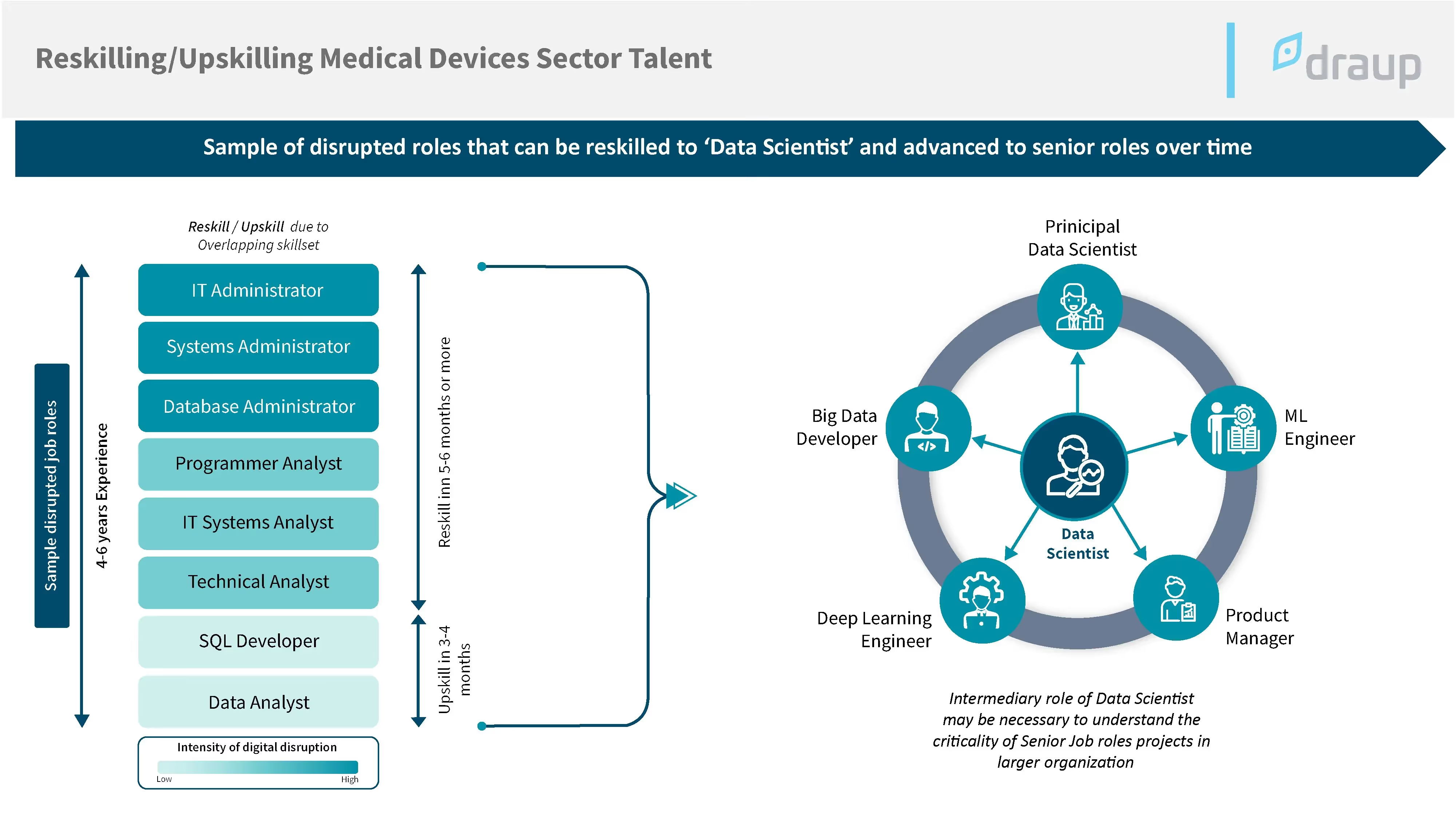Bridging Skills Gap in the Medical Devices Industry: Strategies to future-proof your talent
The medical devices industry has adopted novel methods to maintain product quality, decrease costs, increase efficiencies, and comply with worldwide laws.
Stakeholders must assess if the outdated infrastructure can merge with new technologies or be replaced by more advanced and reliable solutions. Health technology improves patient data security, virtual care, medical research, and more.
The growth of medical devices will expand over the next 5 – 10 years, owing to device conceptualization, manufacturing, and distribution, which were slower before the digital era.
Let us look at a few examples of medical devices:
1. AI-driven medical devices – They help in accurate diagnosis, treatment, and patient monitoring. They also expose patients to less radiation than previous ones.
It can reduce inspection times by providing insights from minor patterns in vast data sets and advanced analytics on how systems work in many circumstances.
It can also read and predict medical device label text, language, symbols, and other assets, and automatically feed this data into a spreadsheet, speeding up tedious processes.
2. 3D-printed devices – 3D printing of medical devices on demand has revolutionized the industry. It uses appropriate materials to print a digital model in layers and prints CT scans, X-rays, MRI scans, and ultrasounds.
3D-developed devices are easier to obtain, making surgery faster, more profitable, and often more successful.
Customized organs, prosthetics, and surgical tools are possible for prototyping and research. 3D printing improves the dental and orthodontic design.
Digital Skills Will Guide the Future of the Medical Devices Industry Talent Management
Medical device companies, like many others, have been hiring the best digital talent to support immediate and long-term growth as competition for tech skills heats up. In today’s tight labor market, hiring externally is unsustainable, costly, time-consuming, and burdensome.
New hires don’t always fit your company, and turnover within the first year will increase costs and disrupt workflow. Any company’s talent strategy should include talent acquisition, but it shouldn’t be the only way to build a strong workforce.
Acquire Skills by Building Competencies
67% of talent management leaders believe reskilling, and upskilling employees effectively addresses talent scarcity, and 40% are actively investing more money into these activities.
Many medical device companies are rethinking talent management strategies and increasing their learning and development budgets to address the skills gap.
As per a 2022 survey of over 17,000 workers, 88% said they would use learning and development initiatives if offered.
Reskilling accelerates career growth and mobility. More digital talent comes from non-related fields. 44% of professionals came from non-technical roles and grew their salaries twice as fast as technical professionals.

Draup conducted a study of tech talent in the medical devices industry. The report demonstrates how talent management can empower the current workforce to advance to in-demand roles with reskilling.
The above infographics illustrate what roles can be reskilled to advance individuals to the role of Data Scientist and then move to more advanced roles like Deep Learning Engineer, ML Engineer, Principal Data Scientist, etc.
Data Administrators can acquire programming, data engineering, analytics skills, and statistical and mathematical modeling skills to advance to a Data Scientist role within six months.
Prepare for In-Demand and Future Skills
Given the scarcity of digital skills and their importance in commercializing devices, medical device manufacturers will need a comprehensive workforce strategy.
This requires a robust skilling program. Talent management must focus on these four areas:
1. Determine digital transformation areas
Talent management must determine whether demand for digital skills will be driven by function (HR, marketing, regulatory, etc.) or by lines of business (orthopedic, telemedicine, disposables, etc.).
Map skills plan scenario based on expected key milestones for pipeline products. Understanding where the business is going makes skilling initiatives much more valuable.
2. Identify individuals to reskill
According to research, workers who can transition their careers into digital roles demonstrate a keen ability to adapt and thrive. Along with a natural curiosity, these people have excellent teamwork and communication skills.
Talent management must provide additional resources to individuals interested in transitioning into technical roles to help them move faster into new career paths. In addition to the technical training, mentoring and coaching can enhance their learning experience.
3. Map adjacent skills and the ‘learning gaps’
Jumping from managing clinical studies to coding firmware may be a big leap. So, talent management must think about which skills are pragmatically adjacent and calculate how long it may take to adequately train employees for new roles.
An employee who devotes excessive time and resources to learning a new skill set leaves two roles unfilled: the employee’s current job and the one they intend to fill. Hiring external talent with the necessary skills makes more sense in these cases.
4. Offer continuous learning opportunities
The constantly innovating industry requires a workforce capable of building and utilizing new and effective technologies. This necessitates ongoing training and development, particularly for the necessary skills to drive digital transformation.
Talent management must assess how the business evolves and determine how upskilling fits into an overall strategy.
The skills gap in the medical devices industry will not diminish soon. Demand for life-improving and life-saving medical equipment will undoubtedly increase, exacerbated by the aging demography.
Companies cannot recruit a successful staff in today’s highly competitive, talent-driven economy. Manufacturers can only manage their human capital needs if they employ an effective approach to upskilling and reskilling.
As reskilling is essential, Draup’s AI-driven reskilling platform makes it easy for talent management to opt for custom reskilling in the face of talent disruption and shortages.
This report provides insights on roles in demand, location analysis, location intelligence, and approach to reskilling to in-demand roles.










.svg)



















.svg)





.svg)
